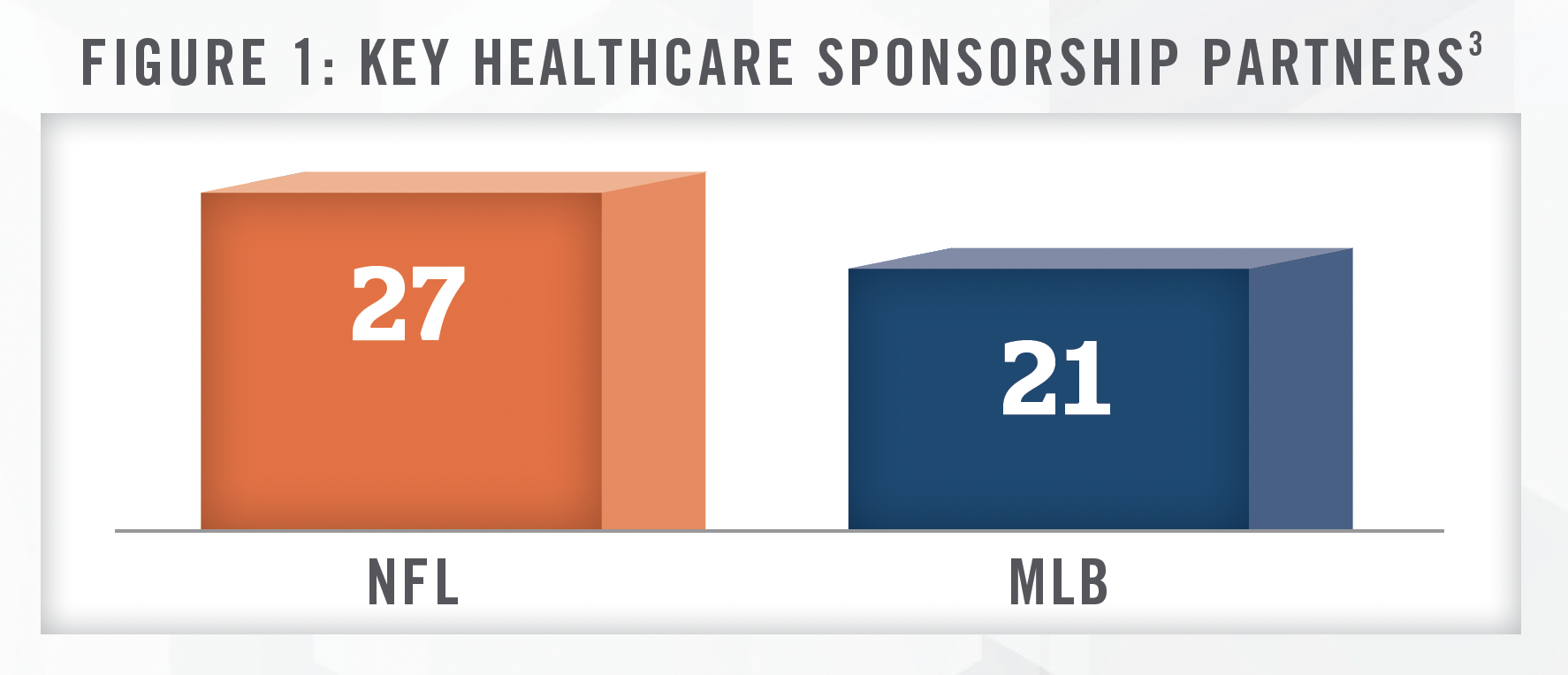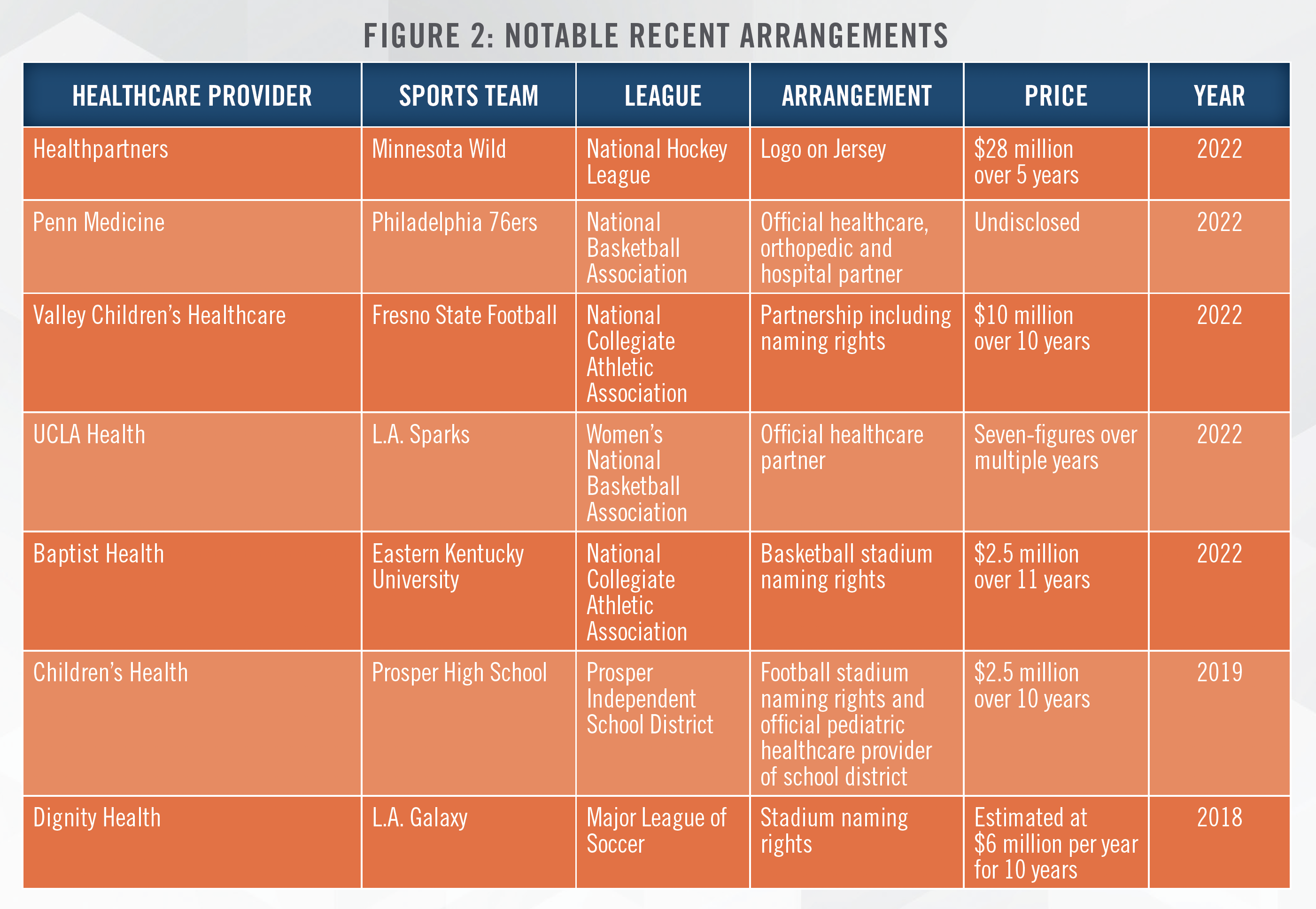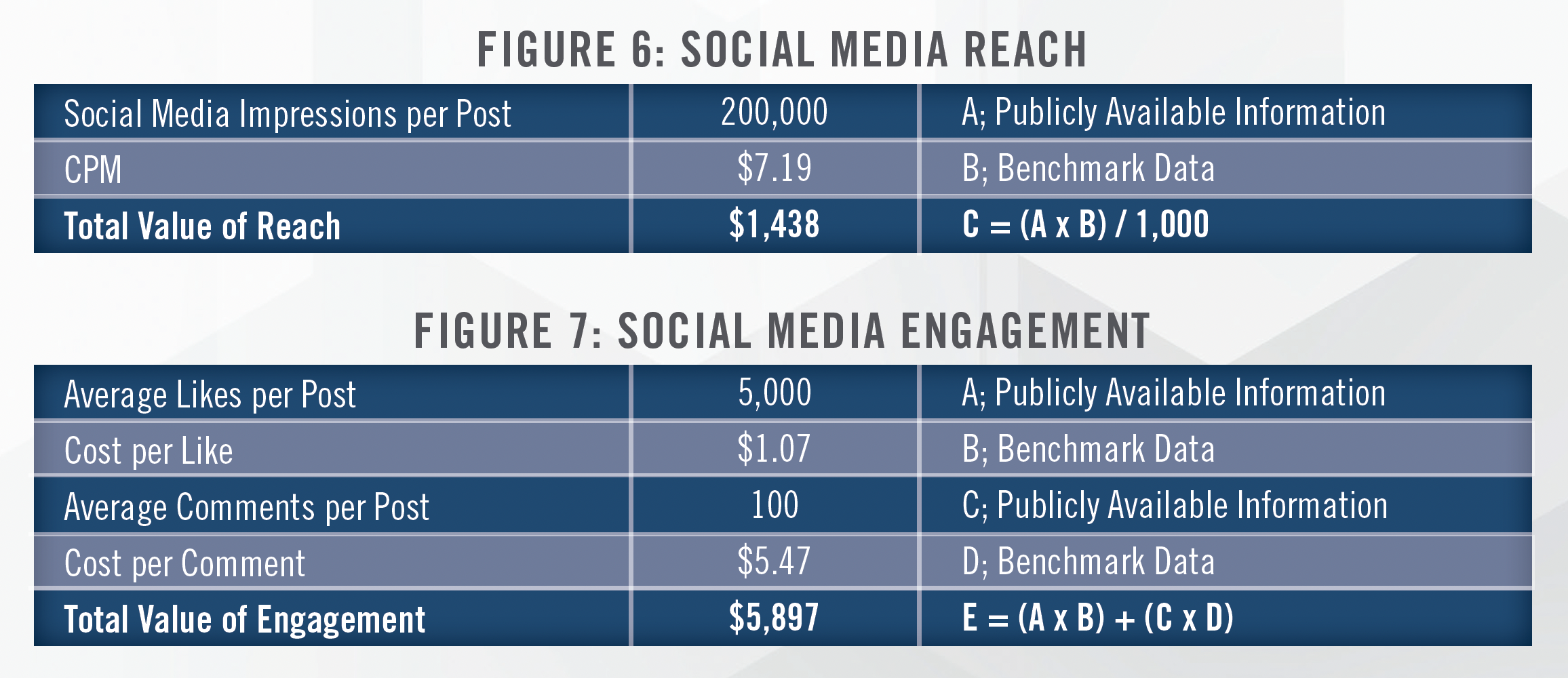
Since the first broadcasted sporting event occurred in 1911 when a football game was relayed to audiences, the United States has been enamored by sports. Today, businesses spend approximately $16.4 billion on sports sponsorships,[1] with 57.5 million consumers in the United States digitally watching sports at least once a month in 2021.[2] Healthcare entities have leveraged this broad affinity for sports into strategies to promote brand exposure within one of the most readily accessible consumer markets in the United States. For healthcare entities and providers to tap into this market, there are certain hurdles that must be overcome. In this article, the authors discuss the benefits associated with sports marketing, and some potential fair market value (“FMV”) pitfalls to avoid when considering these arrangements.
Overview of Healthcare Marketing and Sponsorship Arrangements with Sports Teams
The Carolina Panthers and Jacksonville Jaguars of the National Football League (“NFL”) signed one of the first publicly-disclosed sponsorship deals with healthcare businesses in the mid-1990s. Today, healthcare entities sponsor sports teams at all levels, ranging from physician practices sponsoring local sports teams to large healthcare systems sponsoring major league teams. Figure 1 displays the number of major healthcare sponsors present in the NFL and Major League of Baseball (“MLB”):

Additionally, Figure 2 displays some specific arrangements recently observed in the market. HealthCare Appraisers is also aware of large health systems sponsoring many organizations in their market, such as Advent Health, which sponsors the Orlando Magic, the Tampa Bay Buccaneers, and the Tampa Bay Lightning, along with multiple minor league and collegiate teams as well.[4]

Types of Arrangements
HealthCare Appraisers has observed, and provided valuation services in connection with, a variety of sports sponsorship and marketing arrangements in the marketplace. The two most common arrangements the authors have observed are between a healthcare provider and a sports team, and between a healthcare provider and a professional athlete.
Healthcare Entity and Sports Team Arrangements
HealthCare Appraisers has analyzed arrangements between healthcare providers and sports teams wherein advertising and use of the healthcare provider’s logo and presence on its website were exchanged for specified healthcare services (e.g., orthopedic surgeries, x-rays, MRIs, athletic training, etc.) provided to the sports team’s players for a given time period. An example of one of the more common types of arrangements is children’s hospitals providing athletic trainers to high school athletic departments, but we have observed these types of arrangements between a wide range of providers across all levels of sports organizations (e.g., professional, academic, recreational, etc.). Generally, these services might include care or stabilization related to injuries occurring during games or practices, including broken bones, torn ligaments, and head injuries. Figure 3 presents statistics for injuries during sports games for the NFL, MLB, National Basketball Association (“NBA”), and the National Hockey League (“NHL”):

On the other side of the scale, there are many forms of marketing that can be attractive to a healthcare entity. These include traditional advertising such as displaying a healthcare business’ logo inside a stadium, on team jerseys, or on game tickets and other collateral. With an extensive increase in digitization of certain materials and communications over the past two decades, many new marketing opportunities have become available including advertisements on the sports team’s website, email campaigns for target audiences (e.g., season ticket holders), and branded social media posts.

An arrangement between a healthcare provider and a sports team requires an even exchange of services to avoid regulatory concerns related to the provision of healthcare services. An even exchange of services requires that the services provided by each party are of equal value. If the value scale is not balanced, the healthcare entity could be at risk of violating federal or state law or regulatory policies[6] and could face hefty fines and other penalties. One method to alleviate an imbalanced arrangement is to include cash payments as a part of the arrangement in order to balance the scale. In order to determine whether a cash payment is necessary, the services provided by both parties must be valued.
Healthcare Entity and Professional Athlete Arrangements
Another common type of arrangement observed in the marketplace is between a healthcare entity and a professional athlete. These arrangements typically involve an exchange of activities[7] performed by the athlete for compensation. While there may be fewer regulatory concerns surrounding these types of arrangements if there is no exchange of healthcare services contemplated by the agreement, the healthcare entity contracting with the athlete may want to be aware of how the public might perceive the arrangement should the compensation terms become public. Furthermore, there could be concerns of private inurement if the healthcare organization is structured as a tax-exempt organization under section 501(c)(3) of the Internal Revenue Code.
Non-Sports Related Arrangements
In addition to sponsorship arrangements between healthcare entities and sports teams, HealthCare Appraisers has analyzed various sponsorship arrangements outside of sports. These arrangements typically involve email campaigns, newsletters, and other deliverable advertising that is spread through email and physical address lists. Careful thought and analysis are needed when navigating these arrangements to avoid regulatory constraints surrounding referrals of patients and designated health services. HealthCare Appraisers has analyzed and valued marketing arrangements across the healthcare industry, including those involving hospitals, physician groups, laboratories, behavioral health providers, and others. These arrangements frequently involve the services of third-party marketing companies.
Benefits of Sponsorship Arrangements
The primary benefit healthcare providers seek to realize from sponsorship arrangements is an increase in overall brand awareness within a target market. Sports teams typically have very high popularity in their respective markets, which can be used as a tool for healthcare entities in either expanding market share in an established market or capturing a broader serviceable market as new expansion occurs. As professional athletes maintain the highest level of physical fitness to compete, consumers may perceive that the healthcare business the athlete is associated with will provide the highest level of medical services. Secondary benefits include the promotion of health and wellness in a target market and fundraising for certain programs, which may include medical research, foundation activities, community benefit programs, or philanthropic endeavors.
It is also important to recognize any benefits to be received by the sports team or athlete, as this is a critical aspect of the valuation process. Typically, the major benefit to the sports team is the exchange of money or healthcare services for providing brand exposure to the healthcare entity. However, there are other factors that must be considered. The sports team’s public perception can be greatly improved by partnering with an industry that is perceived as providing social benefit compared to more stigmatized industries like alcoholic beverages and gambling.
Regulatory Hurdles
The most notable regulatory concerns with respect to sports marketing arrangements are related to the Anti-Kickback Statute. A healthcare provider that enters into an arrangement with a sports team involving the exchange of advertising and branding for healthcare services could be at risk of violating the Anti-Kickback Statute if the arrangement does not involve an even exchange of services. For example, if a healthcare provider receives an advertising and branding package from a prominent football team in exchange for providing x-ray and MRI services, but the imaging services are found to be worth more than the advertising and marketing, the provider could be perceived as providing disproportionate value to the team in an effort to induce referrals from the team and its medical staff or the university if the arrangement involves a collegiate sports team. In certain instances, the Civil Monetary Penalty prohibition on beneficiary inducements may also be at issue.[8]
Other constraints that need to be considered include sports league policies. For instance, the NFL permits healthcare providers to reach agreements with teams to provide medical services to the team’s players. However, the agreement cannot be for the exclusive provision of medical services, as the NFL gives teams and players the right to seek medical services from the healthcare provider of their choosing. Additionally, the NFL’s Medical Sponsorship Policy prohibits medical services agreements that are associated with sponsorship agreements. For a healthcare entity to provide medical services to a team and also be a sponsor of the team, two mutually exclusive agreements must be arranged.[9] While it is the responsibility of the sports team to be aware of their league’s sponsorship policies, a healthcare business should be generally aware of the policies applicable to their sponsorship partners.
Public Perception
In addition to the regulatory issues discussed herein, careful thought must be given to how sports marketing arrangements will be perceived by the public. Large payments made by healthcare providers in exchange for branding or marketing rights can quickly bring public scrutiny if the arrangement is negatively viewed by the public. For instance, a non-profit hospital in Indiana was publicly criticized for spending $3 million to rename a minor league baseball stadium in their name.[10] Common arguments against healthcare entities spending money on sports marketing are that the business could use the funds elsewhere to attempt to lower costs for patients or increase wages for employees. Consultation that ensures any cash compensation in exchange for branding or sponsorship rights is FMV can be one of many effective methods to protect against negative public perception. One example of sports advertising that created a ripple effect through the local community is the contemplated stadium naming rights agreement between Florida Atlantic University (“FAU”) and GEO Group, a private, for-profit prison company. In 2013, FAU agreed to sell naming rights for the school’s football stadium to GEO Group, in exchange for $6 million dollars to be paid over the span of twelve years. Following the announcement, six weeks of student protests, faculty uproar, and media scrutiny ultimately drove GEO Group to back out of the deal.[11] Sports teams typically want to avoid negative press as it can have a long-lasting impact on public perception.
Valuation Approaches
When determining the FMV of marketing or sponsorship arrangements, the Cost and Market Approaches are typically utilized. The following figure lays out the definition of each valuation approach:

In the context of sports marketing arrangements, the Cost Approach is best utilized when the valuator can accurately estimate the costs that would be incurred by a hypothetical entity to provide the same services. In an arrangement where healthcare services are being provided as a part of a marketing or sponsorship arrangement, the valuator has a variety of tools and methodologies that can be leveraged to estimate the cost to provide the services. Specifically, valuators can analyze various metrics such as the cost-to-charge ratio, which is a metric commonly tracked by hospitals and health systems on their Medicare Cost Reports that measures the amount of costs incurred relative to what is charged for each medical service. These include both direct and indirect cost allocations. Additionally, there are various publicly available sources that provide information on a variety of providers including information published by CMS and filings for publicly traded healthcare providers. The data can be used to calculate cost on a per unit of volume basis (e.g., visit, discharge, ALOS, bed, patient, etc.). Lastly, benchmark reimbursement rates can be analyzed in conjunction with benchmark profitability margins of comparable businesses to arrive at an appropriate estimate of the costs a hypothetical entity would incur to provide the medical services. HealthCare Appraisers has access to many public and private databases that we utilize in valuing these arrangements.
The Market Approach is best utilized when comparable market data is readily available that can be compared to the contemplated arrangement. When analyzing a sponsorship arrangement that includes branding opportunities at a sports team’s stadium, the valuator can research what other comparable sports entities are charging for similar branding opportunities. We note however, that it is important to select directly comparable entities when applying the Market Approach. A branding opportunity for an NBA team cannot be compared to an opportunity with a high school basketball team. Careful thought must be put into the level of exposure the contemplated branding opportunity presents when selecting comparable arrangements.
Another example in which the Market Approach may be utilized is when a healthcare provider is contemplating entering into a sponsorship arrangement with a prominent athlete. Typically, these arrangements include social media marketing for the healthcare provider through the athlete’s Instagram, Twitter, or other social media accounts. When analyzing this type of arrangement, the value of the social media marketing can be measured by analyzing market data on various social media metrics. Examples include cost per mille (CPM), a metric that tracks the cost incurred by advertisers per 1,000 impressions of a social media post, as well as cost per click (CPC), which is the rate paid by advertisers for each interaction[12] with an advertisement or post. There are multiple ways to approach valuing social media marketing in the context of a sponsorship arrangement. Figure 6 illustrates a method of valuing social media marketing based on the potential views a sponsored post may receive. Figure 7 presents a method of valuing social media marketing based on how much engagement a sponsored post may obtain.

It is common when valuing marketing or sponsorship arrangements to use a combination of the Cost and Market Approaches. For instance, after determining the costs incurred for the provision of medical or marketing services under the Cost Approach, the valuator must apply a reasonable rate of return that a hypothetical entity would expect to earn in exchange for providing the services. The valuator can utilize the Market Approach by gathering benchmark return-on-cost or profit margin data that is comparable to the subject entity and arrangement, which can then be applied to arrive at the FMV of the subject marketing or medical services. Figure 8 displays a sample of publicly available benchmark data that could be utilized when combining the Market Approach with the results of the Cost Approach.

Additionally, the Market Approach can be utilized to corroborate the results of the Cost Approach by analyzing pricing on various active marketing or sponsorship arrangements to compare with and support the results of the Cost Approach.
![]() CONCLUSION
CONCLUSION
While marketing and sponsorship arrangements have the potential to positively impact healthcare providers and sports teams, proper diligence and careful consideration of the potential regulatory and valuation issues are critical, and a thorough analysis will necessarily include assessments of public perception and the appropriateness of market comparables and benchmarks. Appropriate consultation and valuation assistance from competent, experienced partners during the negotiation process can be vital to taking advantage of marketing or sponsorship arrangements. This guidance can assist the healthcare provider in bolstering brand awareness and market penetration while remaining compliant with applicable laws and regulations.
HealthCare Appraisers provides a range of consulting and valuation services, and we are in a position to leverage our experience with sports marketing and sponsorship arrangements to support healthcare organizations and athletes in navigating the entire arrangement process.
Nicholas J. Janiga, ASA is a Partner in our Denver office. Nick can be reached at (231) 218-5375 or NJaniga@hcfmv.com.
Daniel I. Levin, CFA, ASA is a Director in our Indianapolis office. Dan can be reached at (303) 566-3177 or DLevin@hcfmv.com.
Bobby J. Van Dusen, MSAQF is a Senior Associate in our Denver office. Bobby can be reached at (303) 566-3190 or RVanDusen@hcfmv.com.
[1] Statista, “Sports sponsorship – Statistics & Facts,” last accessed November 4, 2022, Sports sponsorship – Statistics & Facts | Statista
[2] Statista, “Digital live sports viewership in the United States,” last accessed November 4, 2022, U.S. digital sports viewership 2021 | Statista
[3] SportsPro Media, “NFL 2021 commercial guide: All the teams, sponsors and broadcasters,” and “MLB commercial guide 2022: Every franchise, every sponsor, all the major TV deals,” last accessed November 4, 2022, NFL 2021: All the teams, sponsors and broadcasters – SportsPro (sportspromedia.com) and MLB commercial guide 2022: Every franchise, every sponsor, all the major TV deals – SportsPro (sportspromedia.com), and New England Baptist Hospital, https://www.nebh.org/who-we-are/partnerships/the-boston-celtics/
[4] Advent Health, “AdventHealth Sports and Entertainment Partnerships”, last accessed February 14, 2023, https://www.adventhealth.com/adventhealth-sports-and-entertainment-partnerships
[5] Harvard University, “Comparing Health-Related Policies & Practices in Sports: The NFL and Other Professional Leagues”, last accessed November 4, 2022, Comparing Health-Related Policies & Practices in Sports: The NFL and Other Professional Leagues by Chris Deubert, I. Glenn Cohen, Holly Fernandez Lynch :: SSRN
[6] National Athletic Trainers Association, “Federal and State Self-Referral and Anti-Kickback Laws”, last accessed February 14, 2023, https://www.nata.org/sites/default/files/Stark-Considerations-for-ATs.pdf
[7] Popular activities include social media endorsement, autographed memorabilia, and attendance at healthcare entity sponsored events.
[8] Foley and Lardner, “Compliance Issues in Hospital and Health System Sports Sponsorships”, last accessed February 14, 2023, https://www.foley.com/en/insights/publications/2022/02/compliance-issues-health-system-sports-sponsor
[9] Harvard University, “Comparing Health-Related Policies & Practices in Sports: The NFL and Other Professional Leagues”, last accessed November 4, 2022, Comparing Health-Related Policies & Practices in Sports: The NFL and Other Professional Leagues by Chris Deubert, I. Glenn Cohen, Holly Fernandez Lynch :: SSRN
[10] Healthcare Dive, “Sports sponsorships picking up steam as healthcare competition increases,” last accessed November 4, 2022, Sports sponsorships picking up steam as healthcare competition increases | Healthcare Dive
[11] University Press, “A timeline recap of FAU’s stadium deal with GEO Group,” last accessed November 4, 2022, A timeline recap of FAU’s stadium deal with GEO Group – UNIVERSITY PRESS (upressonline.com)
[12] An interaction is commonly defined as a click, like, comment, or share of an advertisement or social media post.
[13] Damodaran Online, “EVA and Equity EVA by Industry: US” and “Operating and Net Margins by Industry Sector: US,” last accessed December 13,
